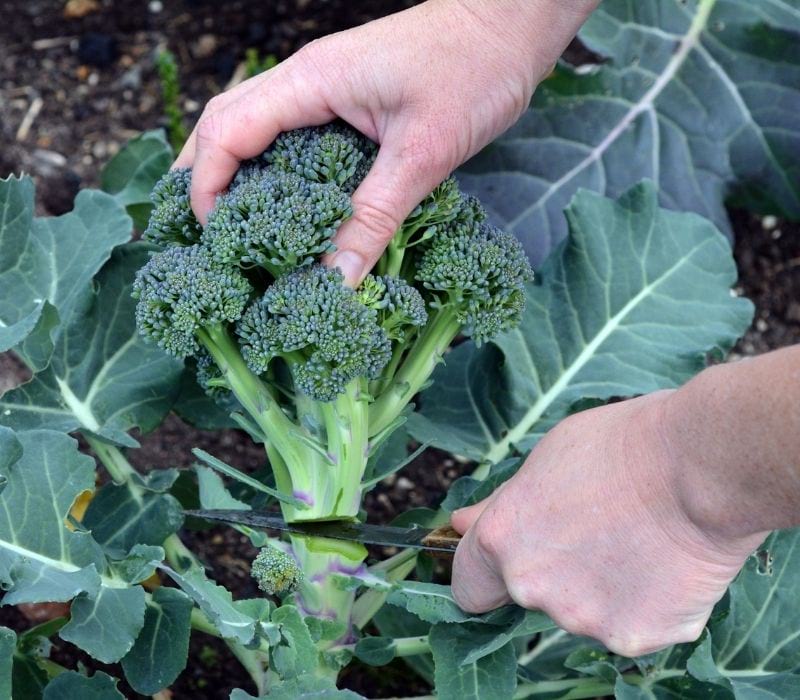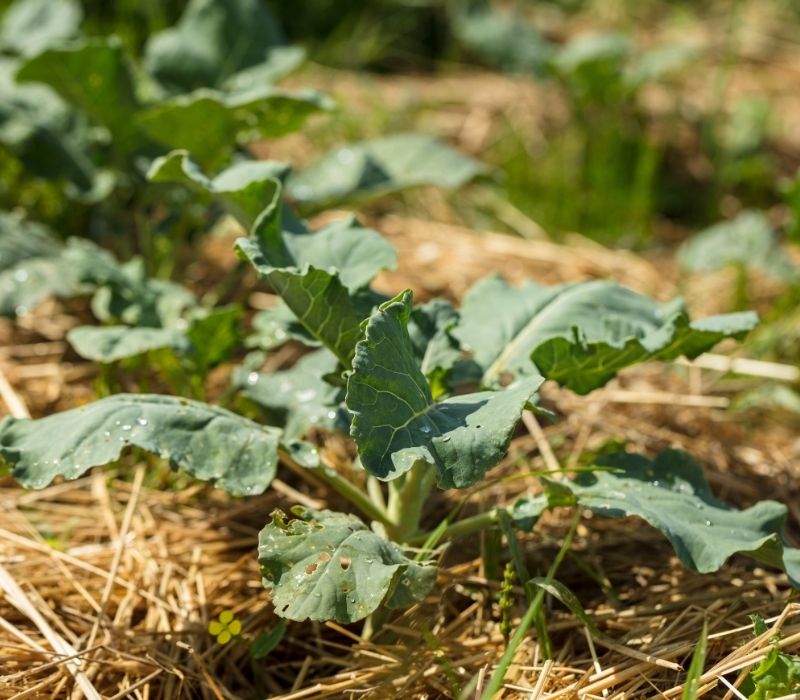Familiarizing yourself with the basics of growing broccoli is something every homesteader should aspire to do. This guarantees a constant supply of protein and fiber right in your backyard or kitchen garden.
RELATED: Best Vegetables For Canning
Everything You Need to Know About Growing Broccoli | FAQs
What Is Broccoli?

Broccoli is a cool-season and sun-loving crop that is best grown in the chillier spring and fall weather. Besides the ease of growing, this vegetable is packed with nutrients and has even been named the “crown jewel of nutrition.”
Why Should You Grow Broccoli?

Though broccoli takes longer to mature, it is worth growing for its vast nutritional value. It is rich in minerals and vitamins – Vitamin A, folic acid, potassium, fiber, and iron.
After harvesting the main broccoli head in your plants, the stalks continue producing smaller side shoots that you can enjoy for months after.
When Is the Best Time to Plant Broccoli?

Being a cool-season crop, broccoli should be started either in late winter or early spring for an early summer crop. Alternatively, start it in mid through late summer for a fall harvest.
Since high temperatures affect the development of the broccoli head – that is, the harvestable part, the idea is to mature the broccoli before or after high temperatures.
Through broccoli seeds can germinate in soil temperatures as low as 4°C, warmer soil is preferred as it will speed up development.
If you want to grow your broccoli in spring, consider starting the seeds indoors or outdoors a few weeks before the last spring frost. That is, six to eight weeks indoors before your last frost or two to three weeks outdoors before the last frost – or as soon as the ground is workable in the spring.
When planting in the fall, sow your seeds 85 to 100 days outdoors before the first fall frost or when soil temperatures are high. This will work best if you are in warmer climates.
Where Should I Plant Broccoli?

Firstly, broccoli will thrive in a spot with full exposure to the sun – that is, six to eight hours of sunlight per day. Lack of full sunlight exposure often leads to thin and leggy plants with subpar heads.
Secondly, your broccoli plants will be happy in slightly acidic between pH 6.0 and 7.0 that is well moist and fertile and drains well.
Tip: Work two to four inches of compost into your soil in early spring to increase fertility. Alternatively, add a thin layer of manure.
How Is Broccoli Planted?

When starting your seeds outdoors, consider sowing them a half-inch deep and three inches apart. Once your seedlings attain a height of about two to three inches, thin them out so that you're left with about 12-to-20-inch space between the plants.
Alternatively, if you started the seeds indoors, transplant your four to six-week-old seedlings outdoors at 12 to 20 inches apart. The holes should, however, be slightly deeper than those in the starting container. Don't forget to water well during this planting time.
Tip: Ensure the broccoli rows are roughly three feet apart. Doing this yields bigger main heads.
RELATED: How To Freeze Vegetables In Your Homestead
What Pests and Diseases Affect Broccoli?

Nitrogen deficiency: Your broccoli plants will need a quick nitrogen fix if you notice a yellow discoloration on the leaves from the bottom upwards. A high nitrogen fertilizer with low phosphorus should solve the problem.
Aphids: More often than not, curled plant leaves mean that insects like aphids have sucked the plant's sap. Applying soapy water on the leaves will keep aphids at bay.
Cabbage loopers: The presence of small holes between the leaves' veins means that small green caterpillars are attacking your crop. Control with a natural, bacterial pesticide or handpick if you can see them. Using a floating cover after planting through harvesting will keep the caterpillars away.
Downy Mildew: Moist weather will leave yellow patches on the leaves. Therefore, keep the leaves dry by ensuring good air circulation. Buying resistant varieties will also help with this issue.
Other pest and diseases include:
- White rust
- Whiteflies
- Cabbageworms
- Cabbage root maggots
How Is Broccoli Harvested?

Cut the broccoli heads from the plant with at least five to six inches of stem. Do this with a diagonal cut on the stalk to ensure the water drains away. This is because a water pool will cause rot at the middle of a flat-cut stalk which ruins the crop's secondary heads.
Usually, broccoli is harvested in the morning as this is when the buds of the broccoli head are firm and tightest – that is before they flower.
Note: Most varieties continue to develop side-shoots after the main head has been harvested. You can enjoy these for many weeks and, in some cases, from spring through fall – if you have a cooler summer.
Tips: Harvest your broccoli immediately when you see yellow petals as the crop's quality rapidly decreases after this.
How Is Broccoli Stored?

You can store your broccoli harvest in many places, from your root cellar to your kitchen countertop or your refrigerator, depending on your harvest size. However, if you choose to store it in a refrigerator, do so for up to 5 days.
Tips
- Packing the broccoli in airtight plastic bags before storing it in the refrigerator will help keep it fresh.
- Ensure you dry the broccoli completely if you wash it before storage.
- You can also blanch and freeze your broccoli harvest for up to one year. Fermenting it is also a great way to increase its shelf life as well as nutrients.
Which Are the Recommended Broccoli Varieties?

Like any other vegetable, broccoli comes in many varieties. Some are hardy while others are not. The trick is to choose a variety best suited to thrive in your climate:
- Flash: This variety is a heat-resistant hybrid that is fast-growing and had a great side-shoot production after the head is harvested. This variety is great for fall planting.
- Calabrese: This Italian heirloom has large heads, and the perfect side shoots that mature for harvesting. It does well as a fall crop too.
- Green Duke: This heat tolerant and early maturing variety is especially recommended for Southern gardeners.
- Green Goliath: This variety is also heat-tolerant and produces prolific heads and side shoots.
- Paragon: This variety is known for extra-long spears and its great freezer storage.
- Green Magic: Like Paragon, the Green Magic also freezes well and is heat tolerant.
What Does Broccoli Care Entail?

Like other plants, broccoli needs care and attention if you want to increase your main heads' quality and the quantity of the side shoot. Here are some pointers you need to keep in mind:
- Broccoli thrives outdoors in 18° to 21°C conditions.
- Ensure you fertilize your seedlings three weeks after transplanting into the garden with a low-nitrogen fertilizer.
- Ensure consistent soil moisture by regularly watering your plants with at least one to one and a half inches of water per week, especially in dry conditions.
- Be cautious, not wet developing broccoli heads when watering to prevent rotting.
- Practice regular mulching around your plants as this will help maintain low soil temperatures. It is also a great way to suffocate weeds.
- Continue fertilizing and watering after the first harvest to encourage the growth of a second broccoli head.
Watch this video from FoundMyFitness on how to grow broccoli sprouts:
There you have it, homesteaders. You are now set to grow this nutrient-rich vegetable in your kitchen garden. What's more, with such a constant supply, you get to try out a wide variety of recipes, from salads to grilled vegetables.
Happy farming!
Do you have more important tips on growing broccoli? Let us know in the comment section below!
Up Next:
- Fermenting Vegetables | Everything You Need To Know
- How To Blanch Vegetables Before Freezing
- Tractor Sprinkler FAQs: How Does It Work?
Fellow homesteaders, do you want to help others learn from your journey by becoming one of our original contributors? Write for us!

Excellent recommendations! These are some very great home renovation ideas. They obviously took a great deal of thinking and imagination to create. The living area has undergone an amazing makeover. Some of these ideas motivate me to try them out at home.